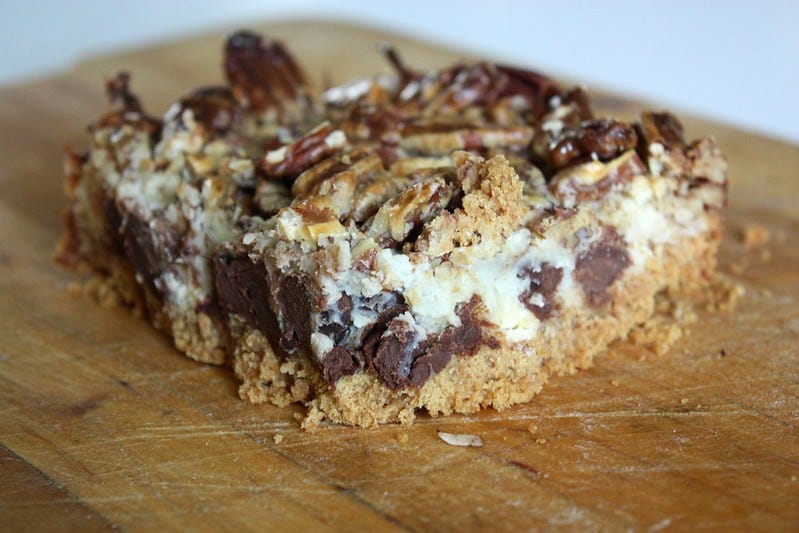If you enjoy the newsletter today, please pass it to someone you know who’d enjoy it, and tap the heart icon above, which will help me reach more readers. I really want to hear from you - hit the comment button and let me know your thoughts! If you’re enjoying Smart Mouth, please consider signing up for a paid subscription. The money goes toward paying our contributors. Substack sets the minimum at $5/month, so you can't give less than that,* but please feel absolutely free to give more.
*If you would like to give less than $5, you can do that via Patreon, and it is very helpful and appreciated! You will also get podcast episodes one week early!
The most science-based episode yet - don’t worry, it was only Nik explaining science, I wasn’t putting on airs. Here's what it comes down to: different people like different foods, and that’s okay.
You can listen to Smart Mouth on iTunes, on RadioPublic, on Spotify - or any other podcast player!
Swimming in Burrata
Lighthouse, in Williamsburg, Brooklyn, is a narrow slip of a restaurant, and the menu has many draws: big salads, a juicy burger, and happy hour oysters. I always order the burrata, which arrives in a bowl, more of a soup than a spherical ball of cheese. It's drizzled with olive oil, and dusted with cracked pepper and flakey salt. Alongside the dish of silky cheese comes several slices of grilled sourdough bread. You and your dining companion will fight over the last piece, which I usually tear in half for the sake of fairness. I've been known to eat the final drops with a spoon, as leaving even a speck behind would be unimaginable.
During the early days of lockdown, I splurged on delivery and got the burrata. In April, it tasted of pure luxury, both of nights sitting at the bar and 1 p.m. brunches. I almost cried at the first bite. I’m a good cook, but I can't grill bread with an electric stove or find burrata this perfect at the supermarket. In September, my best friend and I returned to it again, and marveled at the burrata: its creaminess, its salinity, and its ability to be even better than we remembered it. -Abigail Koffler
145 Borinquen Pl., Brooklyn, NY. (347) 789-7742.
Photo: alanagkelly / Flickr
Love in a Pan
By Stacy Brooks
“I'll bring a pan of bars" is a phrase that echoed through my Minnesota childhood. Bars (not the kind you drink at) were present at every life occasion that involved a crowd: baby showers, town meetings, neighborhood picnics, office potlucks, funeral receptions.
Typically baked in 9x13 inch pans, they're made with ingredients that are shelf-stable and relatively cheap: flour and butter, chocolate chips and marshmallows, shredded coconut and peanut butter. There's nothing trendy about a pan of bars, and that's the point. Bars are comfortable and convenient, meant to please the masses. And like crowded restaurants and the Minnesota State Fair, they’re one of the things I’ve missed the most during months of social distancing.
The oldest bar recipe I can track down is for brownies, in 1904’s “Home Cookery.” In that recipe, credited to Eleanora P. Quinby, bakers are instructed to cut the brownies into bars. My copy of “The Wingold Cook Book,” published by a Winona, Minnesota-based milling company in 1916, contains a brownie-like recipe for “chocolate bars” that would fit right in at a modern gathering.
Photo: Mary Kreul / Flickr
But when it comes to bars, brownies are just the beginning. My favorite are seven layer bars (also called magic bars or Hello Dolly bars), with a base of melted butter and layers of graham cracker crumbs, chocolate chips, butterscotch chips, walnuts, and coconuts, and a final topping of sweetened condensed milk. Scotcheroos are a serendipitous combination of Rice Krispies, corn syrup, peanut butter, and chocolate and butterscotch chips. My mom’s specialty is something called fudge sundae bars, with a thick layer of chocolate sandwiched between oatmeal crusts—I’ve also seen them referred to as hip hugger bars and revel bars.
There aren’t definitive recipes or even consistent names for bars, because they’ve been passed down from family members, coworkers, and newspaper clippings in a culinary game of telephone. That’s still true in the Internet era—I rely on a Google search for just about everything, but when it comes to bars, I pull out my Bethel Lutheran Church cookbook. I page through the recipes for “Grandma’s Date Bars” and “Jean’s Bars,” Swedish brownies and choco mallo bars, and I feel a kinship with all of the bakers who came before me.
I haven’t attended a social gathering since last Christmas, and I don’t know when I will again. Maybe it will be my niece’s second birthday in April, or a Mother’s Day brunch, or a summertime getaway with the friends I’ve known since elementary school.
What I do know is that I’ll bring a pan of bars.🧈
Sources:
Hibbard, L.B. and Vaughan, M.A. (Eds.) (1904). Home Cookery. Laconia Press Association.
von Rohr Sauer, E. (Ed.) (1916). The Wingold Cook Book. Jones & Kroeger, Co.
More Food Reading:
This one got me a little! It’s about starting new Thanksgiving traditions while maintaining the old.
A very compelling history of one of food history’s greatest invention, nachos.
You don’t win friends with salad. You don’t win money with it, either.
This newsletter is edited by Katherine Spiers, host of the podcast Smart Mouth.
A TableCakes Production.
Want to contribute? Here are the submission guidelines.








That burrata DOES look perfect... I would swim in a pool of it.